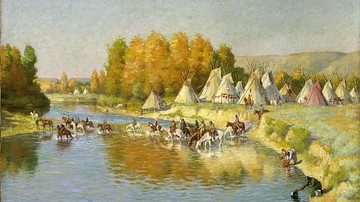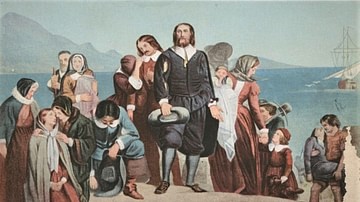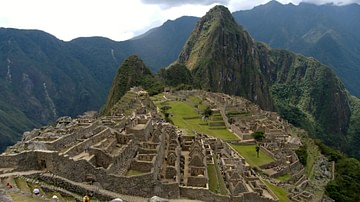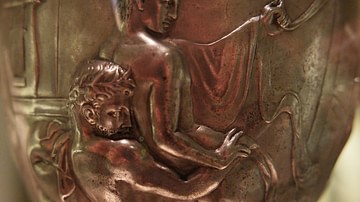The Native Peoples of North America raised cities, built roads, and developed highly sophisticated cultures which encouraged the invention of many items often taken for granted or whose origins are overlooked in the modern day, from aspirin to the water gun and including the bunk bed, canoe, and even maple syrup.
Many innovations, such as the cultivation of maize (corn), initially came from Central and South America but were adopted by the North American nations and became central to their communities. Irrigation techniques, long-distance trade, cities, astronomical calculations, dams and aqueducts, anesthetics, and apartment complexes were all a part of North American Native life long before the arrival of the Europeans, but this understanding of the varied cultures has been obscured by the image of the Native American as the "noble savage" living day-to-day in the wilderness with no concept of 'civilization' or technology. This image has also contributed to the misguided and inaccurate concept of Native Americans as 'anti-science' or 'anti-progress' and resistant to embracing new ideas, as noted by scholars Roxanne Dunbar-Ortiz and Dina Gilio-Whitaker:
One of the biggest challenges for Indigenous people in North America (and elsewhere) is being seen by the dominant populations as peoples with legitimate systems of knowledge, a problem thanks to centuries of white supremacy that constructed Indigenous peoples as inferior in every way. (Indians, 124)
Actually, the indigenous peoples of the Americas have a long history of innovation, invention, and technological development which was only possible because of their openness to new ways of seeing, their respect for the gifts of the natural world and the concept of sustainability, and the curiosity necessary for any kind of invention or cultural development.
These inventions and innovations are:
- Aspirin
- Bunk Beds
- The Canoe
- Maple Syrup
- Moccasins
- Snow Goggles
- Stickball
- Three Sisters Companion Planting
- The Tipi (Teepee)
- Tobacco
These are only a small sample of the many inventions of the North, Central, and South American Natives and focus only on those of North America. Among the inventions not listed below is the syringe, fashioned from a hollow bird bone and an animal's bladder, used to administer medicines, just like today. The syringe inspired the invention – or development – by the Lakota Sioux, of the water gun as a toy for children, one of many examples of Native American ingenuity in adapting one type of technology for another purpose, and, unlike the water guns and other items mass-produced and discarded today, those of the Native American nations were returned to the earth they were made from.
Aspirin
Salicin, extracted from willow bark, was regularly used as a pain reliever and became the Native American 'aspirin' with salicylic acid as the active ingredient. Once salicin was ingested, either by chewing softened bark or consumed in a tea, it reduced fever and relieved headaches, muscle aches, pains caused by arthritis, and other discomforts addressed today by aspirin or various pain relief medications. This remedy is documented in the medical works of ancient Mesopotamia, Egypt, Greece, and Rome but was developed independently by the Native Americans long before European contact. The European pain reliever that came to be known as aspirin was not developed until the latter part of the 19th century.
Bunk Beds
Bunk beds were developed by the Algonquin and Iroquois nations as a space-saving measure in their longhouses. The bed frames were made of wood with a sheet of bark laid lengthwise over a series of cross-spindles. Animal hides served as a mattress over the bark and furs and hides as blankets. Bunk beds were usually two-tiered but could be three beds high, with the top reached by a small ladder. In winter, the top bunks were often used for storage, and the people used only the lower bunks to be closer to the warmth of the central fire. Bunk beds were adopted by the Europeans and then American settlers for use in military barracks, dormitories, and homes.
Canoe
Canoes were made using various techniques but, among the most popular, was the use of controlled fire and an adze, creating the dugout canoe. A suitably large tree was taken down and stripped of its bark and then a fire set along the top. Once the flames had burned a section of the wood, the adze was used to scrape out the charred bits and then the fire was again lit, and the process continued until the trunk had been hollowed out. The interior and exterior were then smoothed and shaped by the adze, knives, or other tools. The kayak, invented by the Aleut, Ainu, Inuit, and Yupik nations developed independently and was a wood or bone frame covered with animal skins and waterproofed with whale fat. The canoe and kayak have remained popular water vessels up through the modern day.

Maple Syrup
The First Nations of Canada and the members of the Haudenosaunee Confederacy were among the first to tap maple trees for their sap and turn it into maple syrup. Although several types of maple trees were used, the sugar maple, whose sap is sweetest, was the most popular. In spring, the Native Americans would cut a small notch in a tree and insert a hollowed reed which would allow the sap to run into a clay bucket or bowl. After it had been left to cure, it was boiled over a fire and turned into syrup, which was then poured into other vessels. Maple syrup was used as a nutritional supplement, to flavor meat, in medicinal remedies, and as a sweetener in drinks, especially the bitter herbal brews which were taken either as a remedy for some sickness or as a preventative. Maple syrup became so popular among the European colonizers that it later became an important trade good.
Moccasins
The moccasin is the footwear most commonly associated with the North American Native nations. Its name comes from mekezin or makasin – the Algonquian word for "shoe" – and it was made of bear, beaver, deer, or elk hide, cut to size, and stitched together, with deerskin as the most popular. The most common form of the moccasin is the shoe, but ankle, calf, or knee-high boots were made using the same technique and both shoes and boots were usually ornamented with beadwork or fringes. Sometimes moccasins were dressed in animal fat for waterproofing, but they could be left undressed if used exclusively indoors, like slippers in the modern era. The moccasin became popular among European traders, beginning with the French in the region of modern-day Canada. They were known as "Indian shoes" and were often bartered in trade.
Snow Goggles
Snow goggles were invented by the Inuit and/or the Yupik nations to prevent snow blindness and improve the wearer's vision. The oldest pair of goggles found thus far are of Inuit manufacture dated to around the 13th century. They were made from antler, bone, or, most commonly, from wood. Each pair would be made for the person wearing them to fit snugly against the face with two narrow slits cut into the wood or bone for the eyes. It is unclear how far back the use of snow goggles goes, but they had already been in use, along with snowshoes, for a considerable time before the First Nations encountered French traders in the 17th century. Snow goggles are still manufactured in accordance with traditional techniques by the Inuit and Yupik today.
Stickball
Stickball was a popular team sport among the Native American Nations of the regions of modern Canada and the northern United States and continues to be played in the present day. The game is similar to lacrosse, which it is based on, but differs in rules and equipment. It is also similar to the ball game of Mesoamerica in that players cannot hold or throw the ball with their hands. Teams score points by sending the leather ball into the opponent's goal using their sticks, not their hands or feet. The game was frequently used to settle disputes between tribal nations. If the outcome of the match proved satisfactory to both parties, war was avoided; if not, war was declared. French and English settlers both came to appreciate the game, and, in the 19th century, the French developed the rules of play into lacrosse.
Three Sisters Companion Planting
The agricultural method of 'three sisters companion planting' was invented by the North American Natives hundreds of years ago, although the precise date is unknown. The 'three sisters' of maize (corn), beans, and squash are planted together, each benefiting the others. Corn is planted first and, once the stalk is established, the beans, which wrap around the corn, and then the squash. The beans help anchor the cornstalk and fertilize the soil, the cornstalk acts as a trellis for the beans, and the large leaves of the squash shade the roots of both beans and corn to keep the soil moist and prevent unwanted weeds. This method, practiced widely across North America by Native American Nations, continues to be used today.
Tipi
The tipi (or teepee) is the historically iconic image associated with the Plains Indians Culture: a tapering tent with poles protruding from an open top. Although the tipi, usually depicted in images of the open prairie, has encouraged the Non-Native view of Native Americans as rootless wanderers rejecting a 'civilized' dwelling, the structure is actually a prime example of technological sophistication. Dunbar-Ortiz and Gilio-Whitaker cite the Cherokee engineer and educator George Thomas on the tipi who notes, "it's a very aerodynamic shape that can withstand high winds and snow loading, with strong convection heating and cooling properties" (Indians, 128).
The historical tipi was made of animal skins sewn together and pulled around poles balanced in a circle and anchored to the ground. The flap that serves as the entrance and exit was usually positioned toward the east to greet the sunrise and the entire structure could be raised and taken down quickly if the people needed to suddenly move to a new location. The raising and disassembling of the tipi was the responsibility of the woman of the family whose home it was, and she was also thought to own everything inside that was not the personal property of her husband.

The tipi is often confused with the wigwam, which looks nothing like it. A wigwam is a shorter, domed, structure historically made of wood and covered in bark. The tipi inspired Henry Hopkins Sibley (l. 1816-1886), then an officer in the US Army, to create his famous Sibley Tent in 1856. Sibley carefully modeled his tent on the tipi, and it proved to be a vast improvement over the bell tents the army had been using. The Sibley Tent then inspired other developments in tent-making and the tipi model is still well-respected by Non-Native campers today as well as continuing as a potent symbol of cultural unity and tradition for Native Americans.
Tobacco
Tobacco was cultivated by the Natives of North, Central, and South America for centuries before it was introduced to Europe by Christopher Columbus after 1492 and then by John Rolfe of the Jamestown Colony in 1611. To the Europeans, and later Americans, tobacco was a lucrative cash crop, but to the Native Americans, it was – and still is – understood as a sacred gift from the Great Spirit and used as a means of communing with the divine. Tobacco smoke was taken into the mouth and then released, carrying one's prayers upwards to the realm of the Creator God and the Spirit World. Tobacco was also smoked as a medicinal herb, used ceremonially – as in the Seven Sacred Rites of the Lakota Sioux – and carried in one's 'medicine bag' for use socially. According to Sioux lore, the supernatural entity known as White Buffalo Calf Woman gave the people the Sioux ceremonial pipe for use with tobacco to maintain their relationship with the Great Spirit. Other tribal nations have their own lore concerning tobacco and its uses, but all regard it as sacred and reject its commercialization and the addictive additives now so closely associated with it. Although tobacco use today is recognized as a health hazard, it was understood, prior to its cultivation by Europeans like John Rolfe, as a potent medicinal and spiritual aid.
Conclusion
Tobacco was regarded as a powerful anesthetic, but so was the datura plant (also used to elevate consciousness in ceremonies) and other flowers and herbs. Dogbane and stoneseed were used as oral contraceptives and sunflower oil, aloe, and fish oils as sunscreen. Native Americans also invented the baby bottle and baby 'formula' – which other ancient civilizations had also created independently – children's toys, the use of ephedra in treating colds, and the popular game of Shinny which influenced the development of both ice hockey and field hockey.
Far from the image of the 'backward' or 'uncivilized' peoples European and American writers of the 17th to early 20th centuries have encouraged, the Natives of North America developed a sophisticated culture equal, and in many ways superior, to that of the Europeans who derided them as 'anti-progress' or 'anti-science'. Dunbar-Ortiz and Gilio-Whitaker comment:
The word "science" as it is commonly used refers narrowly to complex, specialized, and mechanistic systems of measurement to understand what we call reality. Literally translated, however, science refers simply to systematized knowledge. In this sense, all Native peoples have their own structures of empirically based knowledge. From their observations, they developed technologies that made their lives easier, in characteristically sustainable ways. (Indians, 124)
Sustainability, a concept gaining increasing attention in the modern era – along with that of "No Waste" – was, and is, simply common sense to the Indigenous Peoples of North America. Everything that was taken from the earth for the benefit of the people was returned to the earth, just as it was understood that, when one died, one's body would decompose and also return to the land it had come from and lived on.
The importance of sustainability was recognized by the Native Americans centuries before the modern era in which it has become a divisive topic of debate. The Haudenosaunee Confederacy, at least as far back as c. 1500, if not earlier, mandated the 'seventh generation principle' in any decision the nations would make: any resolution concerning natural resources would have to be sustainable for seven generations into the future to ensure that there was a future for the people's descendants. Many of the inventions listed above, and many more that do not appear here, were later developed by Europeans and other non-Native Americans, but this concept, unfortunately, was, and continues to be, ignored.







